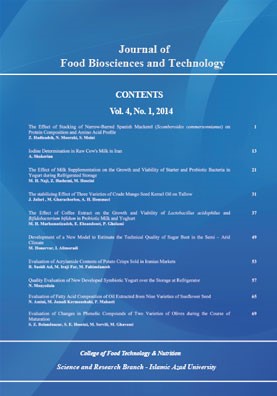Evaluation of Changes in Phenolic Compounds of Two Varieties of Olives during the Course of Maturation
Subject Areas : food microbiologyS. Z. Bolandnazar 1 , S. H. Hoseini 2 , M. Servili 3 , M. Ghavami 4 *
1 - M. Sc. Student of Food Science and Technology, Science and Research Branch, Islamic Azad University, Tehran, Iran.
2 - Assistant Professor of Food Science and Technology, Science and Research Branch, Islamic Azad University, Tehran, Iran.
3 - Professor of Nutrition Department, Peruja University, Peruja, Italy.
4 - Professor of the College of Food Science and Technology, Science and Research Branch, Islamic Azad University, Tehran, Iran
Keywords: Maturation Period, Olive, Phenolic Compounds,
Abstract :
Fats and oils are made of triglycerides. The fatty acids are the main constituents of triglycerides. There are minor components present in the oils and fats that are of great importance in human health, namely tocopherols and phenolic compounds that exhibit antioxidant activities. The concentrations of these compounds vary during ripening and maturation of olives. The object of the present study is to find out the time when the maximum concentrations of these compounds are present in the fruit, therefore the harvesting time can be determined. In the present work, two varieties of olives, Koroneiky and Arbeqina were selected and obtained during the months of Mordad, Shahrivar, Mehr and Aban in Fars province. The phenolic comopounds were determined according to the official method of analysis. The results indicated that phenolic compounds were increased during ripening periods and then started to decline during maturation. It was concluded that for Arbeqina variety the end of Aban and for Koroneiky variety beginning of Azar were selected as the best harvesting point in respect of phenolic compounds concentrations.
Anon. (2009). IOC Standard Method.
Aparicio, R. & Luna, G. (2002). Characterization of monovarietal virgin olive oil. European Journal of Lipid Science and Technology, 104, 614–627.
Boland Nazar, S. Z., Servili, M., Ghavami, M., Hosseini, S. E. & Safafar, H. (2012). Evaluation of changes in fatty acid composition in three different varieties of olives during the course of maturation, Journal of Food Biosciences and Technology, 2.
Boskou, D. (2009). Olive Oil: Minor constituents and health, Ed.1st, Chapter 3, CRC PRESS, pp.12-36.
Bouaziz, M., Chamkha, M. & Sayadi, S. (2004). Comparative study on phenolic content and antioxidant activity during maturation of the olive cultivar Chemlali from Tunisia. J Agric Food Chem., 52, 17, 5476-5481.
Cerretani, L., Bendini, A., Rotondi, A., Mari, M., Lercker, G. & Gallina, T. (2004). Prog Nutr., 6, 50-56.
Fuller, C. J & Jialal, L. (1994). Effects of antioxidants and fatty acids on low-density-lipoprotein oxidation. Am J Clin Nutr., 60, 6, 1010-1013.
Hui, Y. H. (2007). Bailey’s industrial oils and fats products. John Wiley and sons, Inc., publication, Vol. 5, sixth edition.
Owen, R. W., Giacosa, A., Hull, W. E., Haubner, R., Spiegelhalder, B. & Bartsch, H. (2000). The antioxidant/anticancer potential of phenolic compounds isolated from olive oil. Eur. J. Cancer., 36,1235–1247.
Rotondi, A., Bendini, A., Cerretani, L., Mari, M., Lercker, G. & Toschi, T. G. (2004). Effect of olive ripening degree on the oxidative stability and organoleptic properties of Cv. Nostrana di Brisighella extra virgin olive oil. Journal of Agricultural and Food Chemistry, 52, 3649-3654.

